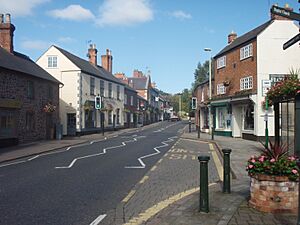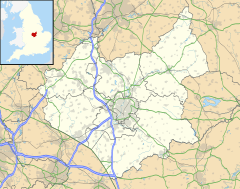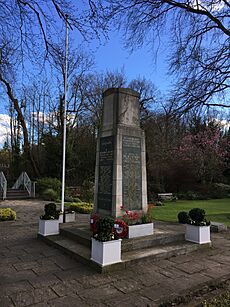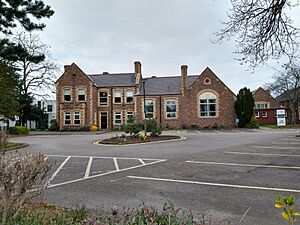Quorn, Leicestershire facts for kids
Quick facts for kids Quorn |
|
|---|---|
 Quorn High Street |
|
| Population | 5,177 (2011) |
| OS grid reference | SK563164 |
| District |
|
| Shire county | |
| Region | |
| Country | England |
| Sovereign state | United Kingdom |
| Post town | LOUGHBOROUGH |
| Postcode district | LE12 |
| Dialling code | 01509 |
| Police | Leicestershire |
| Fire | Leicestershire |
| Ambulance | East Midlands |
| EU Parliament | East Midlands |
| UK Parliament |
|
| Website | Parish |
Quorn is a village in Leicestershire, England. It is located close to the university town of Loughborough. The village's name was shortened from Quorndon in 1889. This change happened to prevent confusion with another village called Quarndon in Derbyshire, which caused problems with mail delivery.
Contents
Discovering Quorn's Past
The first known mention of Quorn was between 1209 and 1235. It was called Quernendon back then. Over the years, its name changed many times. Some old names include Querne, Quendon, and Querondon.
How Did Quorn Get Its Name?
Stone has been dug up in Quorn for a very long time. This happened at a place called Buddon Wood. People quarried, or dug up, granite millstones in the early Iron Age. Later, during the Roman times, stone was used for building in Leicester. You can still see some large millstones around today. They are often used as garden decorations or turned into seats. The village's name likely comes from an old English word, cweorndun. This means "hill (dun) where millstones (cweorn) are found."
Quorn Hall and the Famous Hunt
Quorn Hall was built around 1680 for the Farnham family. In 1753, a famous fox hunter named Hugo Meynell moved there. He started his group of hunting dogs, called a pack, at the hall. This pack continued until 1905, giving its name to the well-known Quorn Hunt. Three ships in the Royal Navy were even named HMS Quorn after the hunt.
Flooding and a Modern Connection
Historically, Quorn has had many floods. This is because the River Soar is very shallow here. The problem got worse in the late 1700s. Locks and weirs were built for the Leicester Navigation, which later became part of the Grand Union Canal. The village is also linked to the meat substitute Quorn. This food product began being made in 1985.
Quorn During the World Wars
Quorn lost 96 men in the two World Wars. Seventy-seven men died in World War I, and 19 in World War II. A special monument, called a cenotaph, in Quorn's Memorial Gardens honors these brave men.
American Soldiers in Quorn
During World War II, a camp was set up at Quorn House. It was used to hold prisoners of war. It also hosted soldiers from the United States Army 82nd Airborne Division. These paratroopers were part of the 505th Parachute Infantry Regiment. They helped free the town of Sainte-Mère-Église in France on D-Day. One famous paratrooper, Pvt. John Marvin Steele, got caught on the town's church spire. Today, a dummy paratrooper hangs from the church in Sainte-Mère-Église to remember this event.
Many American veterans still visit Quorn. They often come back every ten years for D-Day anniversaries. They remember their time in Quorn and their friends who did not return. There is a plaque in Quorn's Memorial Gardens for the lost US servicemen. A poppy wreath is placed there every year on Remembrance Sunday. Also, an avenue of lime trees in Stafford Orchard, the village park, remembers these American soldiers. There is a plaque there too.
Quorn Today: A Lively Village
Quorn is built around the old A6 road. This road used to go right through the village center. But on October 28, 1991, a new bypass opened. This moved the A6 road to the edge of the village.
Quorn and Woodhouse Railway Station
The village has a railway station called Quorn and Woodhouse. It is shared with the nearby hamlet of Woodhouse. This station was once part of the national Great Central Railway network. Now, it is part of the preserved Great Central Railway. Many royal visitors have used this station. They came to take part in the Quorn Hunt, including the Prince of Wales (who later became King Edward VIII). The station is a place of historical interest all year. It also hosts a fireworks display during the Bonfire weekend. You can find a small vintage tea room at the station. There is also the Butler Henderson Café in the main car park.
Old Industries and New Spaces
Sarson Street is next to Rawlins Community College. It has many 19th-century terraced cottages. These were once homes for framework knitters. Framework knitting was a big industry here before machines took over. The cottages on this street have special features from that time. For example, they have large windows to let in enough light for working.
M. Wright & Sons Ltd has been making fabrics at Quorn Mill since 1870. They first made fabrics for shoes and corsets. Now, the factory makes high-tech textiles. These are used in industries like military, aerospace, and leisure.
"The Banks" is a decorated paved area in the village with seating. It is designed to look like the letter 'Q' from above.
Green Spaces and Sports
The village is proud of its green spaces. For example, there was opposition to building on Caves field. This is a large cricket pitch with a pavilion. Quorn Cricket Club plays here during the season. A housing company wanted to build there. But many people objected. They did not want to lose the cricket field. They also worried about a nearby wetland area. Environmentalists and villagers thought this wetland was very important. The Farley Way Stadium is home to the local association football club Quorn F.C.. It is also where Leicester City W.F.C. plays.
In recent years, efforts have been made for young people. A half-pipe was built next to the basketball court in Stafford Orchard. A green shelter was also put up there. The half-pipe was later replaced with ready-made ramps. Stafford Orchard is a large park. It has a shaded area by the stream and a play area for younger kids. It is a place for people of all ages. Stafford Orchard is used for big events like the successful Mayday celebrations. Local pub football matches are sometimes held there too.
In 2016, Quorn was named one of the top five places in the UK to raise a family. This was in a survey by estate agents, Leaders. In 2024, Quorn village experienced extensive flooding after Storm Henk hit the UK.
Important Buildings in Quorn
The Church of St Bartholomew and Farnham Chapel is a very important historical building. It is listed as Grade I.
Quorn House is another important building, listed as Grade II. It was built in 1820. The Farnham family lived there from about 1260 until 1993. Then, fitness instructor Rosemary Conley bought it. Her business used the building until 2015. After that, Tarmac, which runs Mountsorrel Quarry, bought Quorn House. They now use it as office space.
Learning in Quorn
St Bartholomew's Primary School is a Church of England school. It teaches children from early years up to year 6.
In the center of the village, next to St Bartholomew's Church, is Rawlins Academy. This is a secondary school for students from year 7 to Sixth Form. In 2017, it received a "good" rating from Ofsted, and its Sixth Form was rated "outstanding." The school also offers classes for adults and leisure activities. It is built on the site of the old Thomas Rawlins Grammar School for Girls.
Loughborough Grammar School has several sports fields on the edge of the village.
Quorn's Population
The 2011 census showed that Quorn had 5,177 people living there. This was an increase from 4,961 people in 2001. Of the 5,177 people, 2,524 were males and 2,653 were females.
Quorn's Boundaries
The full name, Quorndon, is still the official name of the civil parish.
The River Soar forms much of Quorn's eastern border. It separates Quorn from the village of Barrow upon Soar. This area includes Pilling's Lock and parts of the Grand Union Canal, the Midland Main Line railway, and the A6 dual carriageway. The southern border is with the villages of Mountsorrel, Rothley, and Swithland. It includes Buddon Wood, Mountsorrel Quarry, and part of Swithland Reservoir. The Great Central Railway forms most of the western border with the village of Woodhouse. The northern border includes Bull in the Hollow Farm. It is shared with the hamlet of Woodthorpe and the town of Loughborough.
Famous People from Quorn
- Gordon Banks (1937 – 2019), a goalkeeper who won the 1966 FIFA World Cup.
- Rosemary Conley, a businesswoman, author, and speaker on exercise and health.
- Jeremy Howick, a researcher at University of Oxford and a former international rower. He competed in The Boat Race 1996 for Oxford.
- Jane Hunt, a former Member of Parliament (MP) for Loughborough, representing the Conservative party.
- David Gower, a former England cricket player and current cricket commentator for Sky Sports. He went to school in Quorn for a time, at the Old Primary School.
- Peter Jones, a FA Premier League referee.
- Hugo Meynell of Quorndon Hall (1735 – 1808), who was a pioneer of fox hunting.
- Peter Preston (1938 – 2018), a former editor of The Guardian newspaper.
- Andy Reed, a former MP for Loughborough, representing the Labour party.
- Youri Tielemans, a footballer for Leicester City.
Quorn, Australia: A Village's Namesake
The town of Quorn, South Australia, was named in May 1878. Governor William Jervois of South Australia named it after Quorn, Leicestershire. This was because his private secretary, Mr. J. H. B. Warner, was born there.
Images for kids
See also
 In Spanish: Quorn (Leicestershire) para niños
In Spanish: Quorn (Leicestershire) para niños








